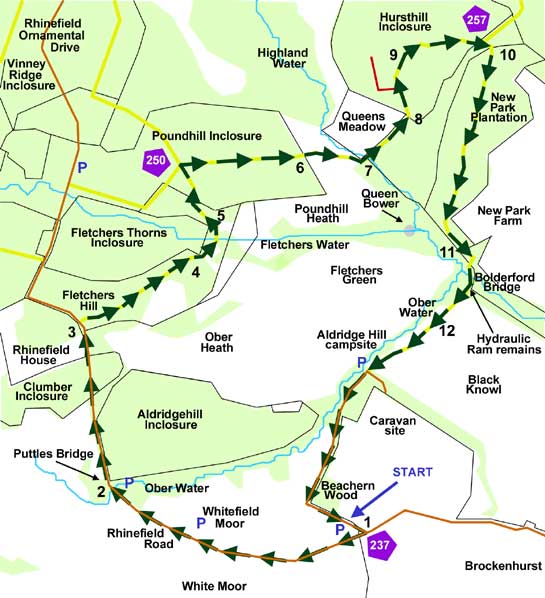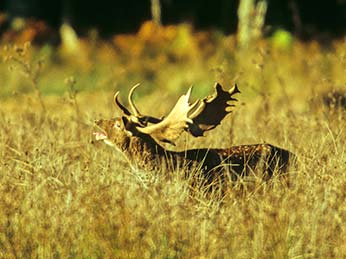New Forest Cycling
Cycle ride 5
Woodland and heathland near Brockenhurst, including Hursthill and Poundhill Inclosures
(Note: on this route there is a river to cross at a ford, which after heavy rain can become virtually impassable).
Start: Beachern Wood car park, on Rhinefield Road (SU 284026).
Station: Brockenhurst, 2.5 kilometres (1 1/2 miles).
Camping in the Forest campsites: Aldridge Hill, on the route, just over 1 kilometre (0.6 miles) north of the start point; and Hollands Wood, 3 kilometres (1 3/4 miles) away.
Alternative starts: Ober Corner car park at SU 284036 (near Aldridge Hill campsite); Whitefield Moor car park on Rhinefield Road - SU 274026; Whitemoor car park on Rhinefield Road - SU 277024; and Puttles Bridge car park on Rhinefield Road - SU 271029. The cycle track through Brick Kiln Inclosure, 2.5 kilometres south-west of Lyndhurst, can also be used to join the route on the edge of Hursthill Inclosure and New Park Plantation.
Distance: 11 kilometres (7 miles), including a short stretch of Rhinefield Road.

Covering a distance of 11 kilometres (7 miles), the route for this cycle ride, like many of the others featured here, is primarily along easy to pedal over, level ground with few, if any, significant gradients.
The ride starts in the Beachern Wood car park, located on Rhinefield Road 1.75 kilometres (1 mile) west of Brockenhurst, although a variety of alternative starts are available - see the separate panel for details - including the option of joining the route from Pinkney Lane and Brick Kiln Inclosure, both on the outskirts of Lyndhurst. The Aldridge Hill campsite is virtually on the route, whilst Hollands Wood campsite is also relatively nearby.
The early, road-based section of this ride provides open views over the heaths and bogs of White Moor, and the extensive grasslands of Whitefield Moor, which was re-seeded following World War Two cropping - part of Black Knowl, further along the route, is another similarly re-seeded area and so is part of Wilverley Plain, visited during cycle ride 9. Inclosure and ancient, unenclosed woodlands are subsequently visited and so are a number of other heathlands; whilst Ober Water, Fletchers Water and Highland Water, all attractive, in places gravel-bottomed, streams add further variety to the route.

on Queens Meadow
And of course, with such a wide range of habitats present, the potential for wildlife interest is correspondingly high, including the very real prospect, especially early and late in the day, of enjoying views of red deer, fallow deer and roe deer - look out for fallow and red deer particularly in and around Queens Meadow.
Of the inclosures passed along the way, Aldridgehill Inclosure perhaps best illustrates the dynamic nature of some of these woodlands. Few were simply planted (or sown) and left for the trees to grow into old age, decay and fall, but were at various times felled in whole or in part to, for example, provide navy shipbuilding timber, and during both World Wars. Aldridgehill Inclosure, according to a commemorative metal plate placed within the inclosure during the early years of the 20th century, was first 'inclosed in 1775', making it one of the earliest New Forest inclosures, and was again 'inclosed' in 1809. 'Thrown out' - the inclosure fences were removed - in 1843, it was subsequently 're-inclosed' in 1903.
Hursthill Inclosure was first enclosed in 1808 and includes many old oaks that appear to be from the original planting. Fletchers Thorns Inclosure dates back to 1829 and comprises many mature broad-leaved trees, but with considerable quantities of conifers close to the cycle track. New Park Plantation is another 1829 inclosure with many oaks that appear to be from the original planting, some beech and a few conifers, including large, ornamental examples. Clumber Inclosure - mixed, well-spaced conifers and broad-leaved trees - dates back to 1843, whilst Poundhill Inclosure, primarily conifers with a small number of broad-leaves, is the baby of the group: it was first enclosed in 1859.
Other historical interest along the route is provided by Rhinefield House - it's close to where the cycleway leaves Rhinefield Road at Fletchers Hill - a grand 19th century country house that is now a hotel; and New Park, also the home of a luxury hotel but of considerably greater age than Rhinefield House, the lands of which are skirted near New Park Plantation.
Also associated with New Park, close to the track near Bolderford Bridge, can be found elements of a mid-19th century hydraulic ram system used to pump water from the river up to a storage tank in the grounds of the park - there is square, brick chamber straddling a narrow, often dry water channel, whilst further along the channel is a dilapidated, roofless building housing part of the pump mechanism. (The age of New Park suggested by the name is misleading - it was first recorded in 1484, and the name served to distinguish it from Lyndhurst Old Park).
The route
(Only designated cycle tracks are usually mentioned below and shown on the map (as yellow lines), not footpaths and other tracks. Cycle route marker post numbers are also shown).
1) From Beachern Wood car park, turn right onto Rhinefield Road, and pass alongside the grasslands of Whitefield Moor.
2) Cross Ober Water at Puttles Bridge, and continue along the road beside Aldridgehill Inclosure, and then through Clumber Inclosure.
3) Notice Rhinefield House on the left, before, opposite the house, taking the turn to the right to join the cycle track through/beside Fletchers Thorns Inclosure. (An advance warning sign here advises caution when crossing the ford quite a distance up ahead).
5) Follow the track over an open area, into Poundhill Inclosure. After a short distance, turn right at a ‘X’ roads – cycle track sign number 250 – and continue through the wood for 0.75 kilometres (1/2 mile).
6) Leave the inclosure through a gate, and cross a corner of Poundhill Heath, the start of a Wildlife Conservation Area in which it is requested that dogs be kept on a lead and disturbance avoided.
7) Cross Highland Water at a bridge, and go on beside the enclosed grasslands of Queen’s Meadow.
8) Pass through a gate into Hursthill Inclosure, and after a short distance, ignore a turn on the left – it is not a cycle track.
9) Continue on for 0.75 kilometres before going through a gate and immediately after, turning right at a ‘T’ junction – cycle track sign number 257.
10) Almost immediately, go through another gate into New Park Plantation – the agricultural land of New Park will soon be seen through the trees to the left.
11) After 1.5 kilometres (1 mile), leave the inclosure through a gate, almost immediately follow the cycle track as it bears right and after a further short distance, pass through another gate to reach Highland Water at Bolderford Bridge.
12) Continue beside Black Knowl, and then along a tarmac road through ancient, unenclosed woodland bordering Ober Water, before cycling alongside Whitefield Moor and back to the start point. (Notice along here the coppiced hazels in the hedgerow to the left of the track, and the aged, oak pollards to the right).
Quick linksMore links
Search this site

Sadly, 58 animals were killed - 35 ponies, 13 cows, 8 donkeys and 2 sheep, whilst a further 32 were injured - 3 pigs, 9 donkeys, 11 cows and 9 ponies.
(Forty-three accidents occurred in daylight, 15 at twilight and 101 in the dark. Twenty-seven accidents were not reported by the driver involved).
Here's just one horrific example - Three donkeys killed in collision with van at notorious New Forest blackspot (Advertiser and Times)

